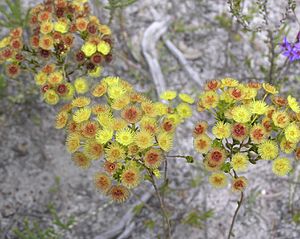Verticordia subulata facts for kids
Quick facts for kids Verticordia subulata |
|
|---|---|
 |
|
| Verticordia subulata in the Stirling Range National Park | |
| Scientific classification | |
| Genus: |
Verticordia
|
| Species: |
subulata
|
Verticordia subulata is a beautiful flowering plant found only in the south-west part of Australia. It belongs to the myrtle family, called Myrtaceae. This plant is a woody shrub with unique pointed leaves and pretty yellow flowers that turn red as they get older. You can often see its flowers in spring.
Contents
What Does It Look Like?
Verticordia subulata is a shrub that usually grows to be about 10–70 cm (4–30 in) tall. It can spread out from 5–40 cm (2–20 in) wide. It usually has one main branch coming from the ground.
Leaves and Flowers
The leaves are long and thin, like tiny spears, and they are pointed. They grow to be about 10–20 mm (0.4–0.8 in) long. The leaves closer to the flowers are a bit shorter.
The flowers have a light scent. They grow in groups on straight stalks that are about 5–10 mm (0.2–0.4 in) long. The base of the flower, called the floral cup, is shaped like a top and is about 1.5 mm (0.06 in) long. It has small ridges and is smooth.
The sepals are yellow and turn a deep red as they get older. They are about 3 mm (0.1 in) long and have 8 to 10 fuzzy parts. The petals are the same color as the sepals and are also about 3 mm (0.1 in) long. They have long, pointed, finger-like parts. The style, which is part of the flower's reproductive system, is about 0.5–1 mm (0.02–0.04 in) long and straight. This plant blooms from September to October.
How It Got Its Name
The plant Verticordia subulata was first officially described in 1991 by a scientist named Alex George. He found the plant in the Stirling Range National Park with Elizabeth George. The description was published in a science journal called Nuytsia.
The second part of its name, subulata, comes from a Latin word subula. This word means "an awl", which is a pointy tool. This name was chosen because of the shape of some parts of the flower.
Where It Grows
This Verticordia plant is found in several areas of Western Australia. You can find it between the Beaufort River, Kalgan, Lake King, and the Stirling Range National Park.
It likes to grow in clay and sandy soils, sometimes over a type of soil called laterite. You can see it on flat areas and small hills in places like heathlands, shrublands, and open woodlands.
Is It Protected?
The Western Australian Government's Department of Parks and Wildlife says that Verticordia subulata is "not threatened." This means it is not currently in danger of disappearing.
Growing This Plant
This pretty shrub can be grown from cuttings, which are small pieces of the plant. The best time to take these cuttings is late in spring.
It grows slowly and needs soil that drains water well. It also needs a sunny spot to help prevent it from getting plant diseases caused by fungi.

